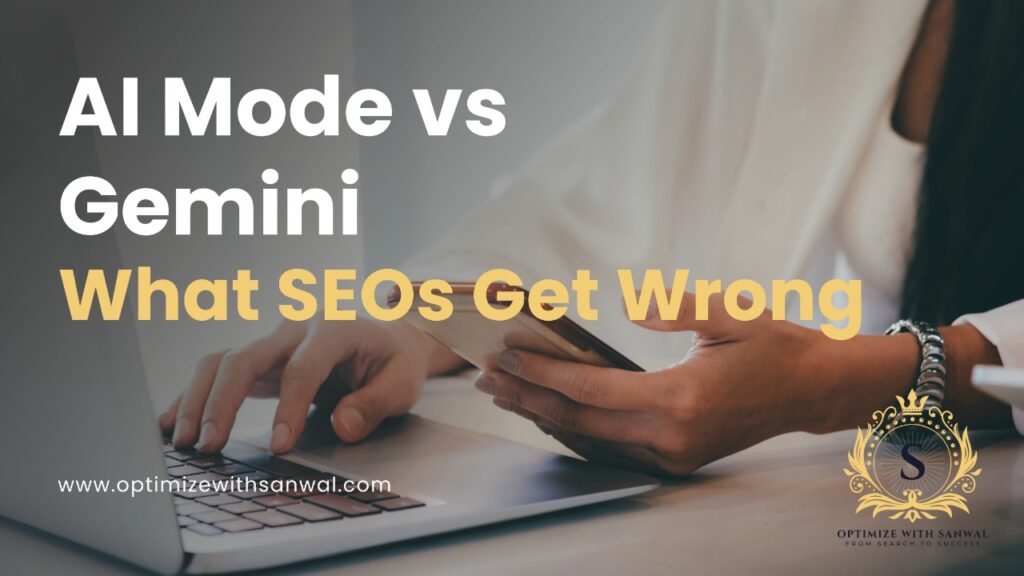What Is the Difference Between Google AI Mode and Gemini? (And Why It Matters for SEOs and Marketers)
Is Google AI Mode just another name for Gemini? Or are they completely different tools shaping how people search, learn, and interact with information online? If you’re serious about SEO, content strategy, or AI-era brand visibility — you need to understand this difference before your competitors do.
The confusion is understandable. Google has launched so many AI-related products and features that even seasoned professionals struggle to keep track. But here’s the thing: mixing up Gemini and Google AI Mode isn’t just a terminology issue. It can lead to misaligned strategies that waste time and resources.
When you understand what each tool actually does, you can create content that works with both systems instead of against them. This knowledge becomes your competitive advantage in a landscape where most marketers are still figuring out the basics.
Is Google AI the Same as Gemini?
Let’s clear up the confusion right away. No, Google AI Mode and Gemini are not the same thing, though they work together in ways that make them seem interconnected.
Gemini is Google’s large language model (LLM), the evolution of what used to be called Bard. Think of it as the brain that can read, understand, and generate human-like text. It’s the technology that powers conversations, summarizes content, and helps with creative tasks.
Google AI Mode, on the other hand, is a system-wide search behavior layer that’s powered by Gemini, SGE (Search Generative Experience), and other AI tools. It’s the way Google now delivers search results, decides what information to show, and determines how users interact with search content.
Here’s a simple analogy: Gemini is the engine. AI Mode is the vehicle. The engine provides the power and intelligence, but the vehicle determines how that power gets used and experienced by the end user.
The average user sees both in action but doesn’t understand the technical split. They might chat with Gemini in the Gemini app, then see AI-generated summaries in Google search results powered by the same underlying technology, but delivered through different interfaces.
SEO Tip: Don’t confuse model vs experience. Google AI Mode is not something you install — it’s how the search experience is changing behind the scenes.
Breaking It Down — The Real Difference Between Google AI Mode and Gemini
Understanding the technical distinction helps you make better strategic decisions. Let’s break down what each system actually does and how they impact your content.
Google Gemini = The Intelligence Layer (LLM)
Gemini has an interesting history. It started as Bard, Google’s response to ChatGPT, then evolved into Gemini, and now we have Gemini 1.5 with even more advanced capabilities. But the core function remains the same: it’s a language model that can understand and generate text.
You’ll find Gemini integrated across Google’s ecosystem. It powers conversations in Google Workspace, helps with tasks in Gmail and Google Docs, runs the Gemini mobile app, and contributes to Search Labs experiments. The technology is designed to be versatile and adaptable to different use cases.
What makes Gemini particularly powerful is its ability to handle summarization, maintain context across conversations, and access real-time information. When you ask Gemini a question, it doesn’t just match keywords — it understands the intent behind your query and provides relevant, contextual responses.
Google AI Mode = The Behavior Layer (Search UX)
Google AI Mode is how this intelligence gets applied to search behavior. It’s the system that decides whether to show you a traditional list of blue links or provide an AI-generated summary at the top of search results.
You see AI Mode in action through Search Generative Experience (SGE), AI Overviews, and the increasing number of zero-click answers. It’s not a separate product you can access directly — it’s how Google now delivers, suppresses, or expands content based on what it thinks users need.
This behavior layer is constantly making decisions about content visibility. Should users see a quick answer or explore multiple sources? Should they get a summary or dive deeper into specific websites? These decisions happen in real-time and significantly impact how your content gets discovered and consumed.
Why This Distinction Affects Your Strategy
Here’s where it gets strategically important. AI Mode affects your content visibility — whether users see your website, how prominently it appears, and whether they click through to read more. This impacts your traffic, brand exposure, and conversion opportunities.
Gemini affects how your content is understood — whether the AI can accurately interpret your message, extract key information, and represent your expertise when generating responses. This impacts your authority, citation frequency, and long-term brand reputation.
You need to optimize for both systems simultaneously. This means creating content with clear technical structure that Gemini can understand, while also formatting it in ways that work well within AI Mode’s user experience patterns.
The Shift from SEO to AEO — Now It’s About Being Read, Not Just Ranked
📘 Download My Free Ebook: SEO vs AEO in the Age of Google AI Learn how Gemini, AI Mode, and SGE are changing everything — and what frameworks to follow in 2025.
The traditional SEO playbook focused on getting your website to rank high in search results. The assumption was that higher rankings meant more clicks, which meant more traffic and conversions. But AI Mode changes this equation completely.
What Is AEO (Answer Engine Optimization)?
Answer Engine Optimization is about aligning your content with AI snapshots and summaries, not just traditional blue links. Instead of optimizing primarily for click-through rates, you’re optimizing for inclusion in AI-generated responses.
This shift requires a different approach to content creation. Instead of writing articles that entice users to click through, you need to create content that provides comprehensive value even when it’s summarized or cited by AI systems.
For example, a traditional SEO article might use an intriguing headline and save the best information for later in the piece. An AEO-optimized article puts the most valuable information upfront in a format that’s easy for AI systems to extract and reference.
Keywords Are Not Enough — Gemini Understands Context
The old approach of keyword stuffing doesn’t translate to visibility in AI Mode. Gemini is sophisticated enough to understand semantic meaning, context, and user intent beyond literal keyword matches.
This means your content needs semantic depth and entity clarity. Instead of repeating the same keywords multiple times, you need to thoroughly cover topics with related concepts, supporting details, and comprehensive coverage that demonstrates real expertise.
Gemini rewards content that shows genuine understanding of a topic. It can detect when content is artificially optimized versus genuinely informative. This shift favors subject matter experts and penalizes content farms that prioritize quantity over quality.
Structured Data + Topical Authority Matter More Than Ever
Rich snippets and schema markup become crucial in the AI Mode era because they help both Gemini and AI Mode understand your content’s structure and context. But technical optimization alone isn’t enough — you need demonstrated topical authority.
Content layering becomes essential. This means creating content that works on multiple levels: immediate answers for quick queries, detailed explanations for complex topics, and comprehensive resources for in-depth research. AI systems can then pull the appropriate level of detail based on user intent.
Practical Scenarios — How AI Mode vs Gemini Affects You
The impact of these systems varies depending on your role and objectives. Let’s explore how different professionals should think about these changes.
If You’re an SEO
Your strategy must account for AI ranking layers, not just traditional Googlebot crawling and indexing. This means understanding how Gemini interprets your content and how AI Mode decides whether to surface it to users.
You need to start measuring different metrics. Traditional rankings and click-through rates are still important, but you also need to track citation frequency, inclusion in AI summaries, and share of voice in AI-generated responses.
The technical aspects of SEO remain important, but they’re now just the foundation. You need to layer on content quality, authority signals, and user experience factors that AI systems can recognize and value.
Putting Quality into Practice
Measuring these new quality factors is the next critical step. To put this into practice, I developed a suite of free tools called the AI SEO Toolkit. It includes a Content Grader which specifically analyzes your text for many of the content, authority, and user experience signals that AI systems value. It provides a score and a checklist to help you optimize your content before you publish. You can explore the toolkit here: AI SEO Toolkit.
If You’re a Writer or Marketer
Gemini interprets tone, structure, and answer depth in ways that traditional search engines couldn’t. This means your writing style, content organization, and level of detail all impact how AI systems understand and present your content.
You need to write for both human readers and AI interpretation simultaneously. This requires clarity in structure, comprehensive coverage of topics, and natural language that doesn’t sacrifice readability for optimization.
Your content needs to anticipate how it might be summarized or cited. This means including key information in formats that are easy to extract while maintaining engagement for readers who consume the full piece.
If You’re a Business Owner
AI Mode may skip your website entirely if your content isn’t optimized for summarization. This could reduce direct traffic but might increase brand visibility if your content gets cited in AI responses.
You need to think about the customer journey differently. Traditional funnels assumed users would visit your website at some point. AI Mode might deliver your expertise to users without them ever clicking through to your site.
This shift requires balancing authority building with conversion optimization. You want to be recognized as an expert source while still driving business results.
Side-by-Side — What Google Gemini Does vs What AI Mode Changes
Here’s a clear comparison to help you understand the practical differences:
| Feature | Google Gemini | Google AI Mode |
| What It Is | AI Language Model (LLM) | AI-enhanced search behavior |
| Where It Works | Gmail, Docs, Search Labs, Gemini App | Search results, mobile, overviews |
| How It Affects You | Understands & rewrites your content | Decides if users see your site or not |
| Focus Area | Comprehension & generation | UI, visibility & scroll behavior |
| Your Control | Content quality & structure | User experience & value delivery |
| Measurement | Content understanding accuracy | Visibility share & citation frequency |
This comparison shows why you need different strategies for each system. Gemini optimization focuses on content quality and comprehension, while AI Mode optimization focuses on user experience and visibility.
How to Adapt Your SEO for Both Gemini and AI Mode
Here’s a practical framework for optimizing your content strategy for both systems:
- Build Topic Clusters With Contextual Coverage
Instead of creating isolated articles for individual keywords, develop comprehensive topic clusters that cover entire subject areas. This helps Gemini understand the relationships between different concepts while giving AI Mode multiple angles to present your expertise.
Start with a pillar page that covers a broad topic, then create supporting content that addresses specific subtopics, related questions, and practical applications. Link these pieces together in ways that create clear topical relationships.
- Use Structured Data (FAQs, How-To, Review Schema)
Schema markup becomes your secret weapon for both systems. FAQ schema helps Gemini understand common questions and answers, while How-To schema provides step-by-step information that AI Mode can present in digestible formats.
The review schema adds credibility signals that both systems recognize. Product schema helps with commercial queries. The key is implementing a schema that matches your content’s actual structure and purpose.
- Write for Gemini Understanding (Clarity, Format, Intent)
Gemini responds well to clear, well-structured content that directly addresses user intent. Use descriptive headings, logical flow, and natural language that explains concepts thoroughly without unnecessary complexity.
Format your content with clear sections, bullet points where appropriate, and definitive statements that can be easily extracted and cited. Avoid ambiguous language that might confuse AI interpretation.
- Monitor Visibility Share, Not Just Traffic
Traditional SEO metrics don’t tell the complete story in the AI Mode era. You need to track how often your content appears in AI summaries, gets cited in responses, and influences user decisions even when they don’t click through.
Use tools that can track brand mentions in AI-generated content, monitor your share of voice in AI responses, and measure the authority signals that AI systems recognize.
Stay Ahead of the Curve — Join Me for Real-Time AI SEO Teardowns
Hi, I’m Sanwal Zia, an SEO Strategist with over 5 years of experience helping brands navigate Google’s changing ecosystem. I’ve guided businesses through major algorithm updates, mobile-first indexing, and now the AI revolution that’s reshaping how people find and consume information online.
🎬 YouTube Walkthroughs of AI Mode behavior, Gemini experiments, and future SEO frameworks. 👉 Watch my YouTube channel
💼 LinkedIn Follow me for data-backed SEO strategy, content breakdowns, and AI-era search changes. 👉 Connect with me on LinkedIn
Final Thought — You’re Not Competing with Gemini, You’re Training It
AI isn’t replacing search — it’s revealing who’s truly optimized for user intent. The businesses that understand the real difference between Gemini and Google AI Mode won’t just survive this shift — they’ll lead it.
Every piece of content you create is essentially training data for how AI systems understand your expertise. When you optimize for both Gemini’s comprehension and AI Mode’s user experience, you’re not just improving your search performance — you’re building long-term authority that compounds over time. The companies that figure this out first will have a significant advantage as AI becomes more integrated into the search experience. The question isn’t whether this shift will continue — it’s whether you’ll be positioned to benefit from it.
Powered by OptimizeWithSanwal


